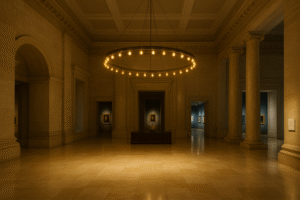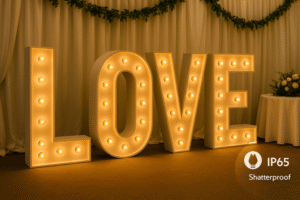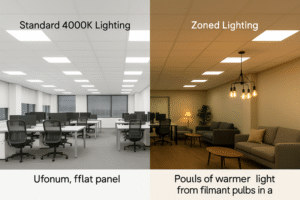Are you worried about choosing the wrong light color? A simple mistake can ruin the entire mood of a space, leading to customer complaints and a warehouse full of unsellable inventory.
Choose warm white (2700K-3000K) for cozy, relaxing spaces like living rooms and restaurants. Select cool white (4000K+) for modern, task-oriented areas like kitchens and bathrooms where clarity and brightness are key. The right choice depends entirely on the intended atmosphere.
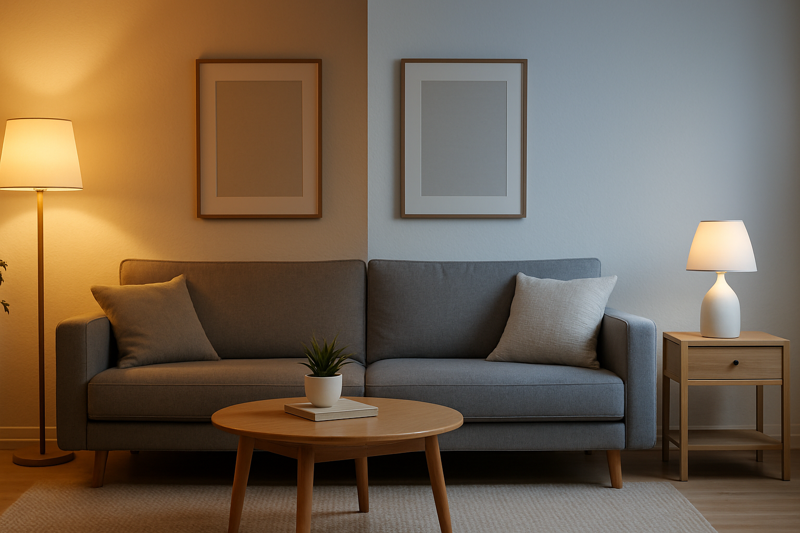
This is one of the most frequent and important conversations I have with buyers. The choice between warm white and cool white isn't just a technical detail; it's an emotional one. It determines how a person feels when they walk into a room. I remember working with a new client who was developing a lighting plan for a chain of high-end, traditional-style hotels. He initially specified 4000K neutral white for all the chandeliers and sconces, thinking "white is white." I had to pause the conversation and explain that this choice would make his cozy, classic hotels feel cold and sterile, like an office or a clinic. We changed the entire order to 2700K warm white bulbs. That simple change preserved the brand's intended atmosphere and likely saved them from countless guest complaints. Understanding this difference is crucial for anyone selling lighting.
What exactly is "Color Temperature" or CCT?
Are you confused by technical terms like Kelvin and CCT on a spec sheet? Ignoring this detail is a gamble that can lead to ordering bulbs that create the wrong ambiance for your customers.
Color Temperature (CCT) is a scale that measures the color appearance of light, from yellow to blue. It's measured in Kelvin (K). Low Kelvin values (like 2700K) mean warm, yellowish light, while high values (like 5000K) mean cool, bluish light.
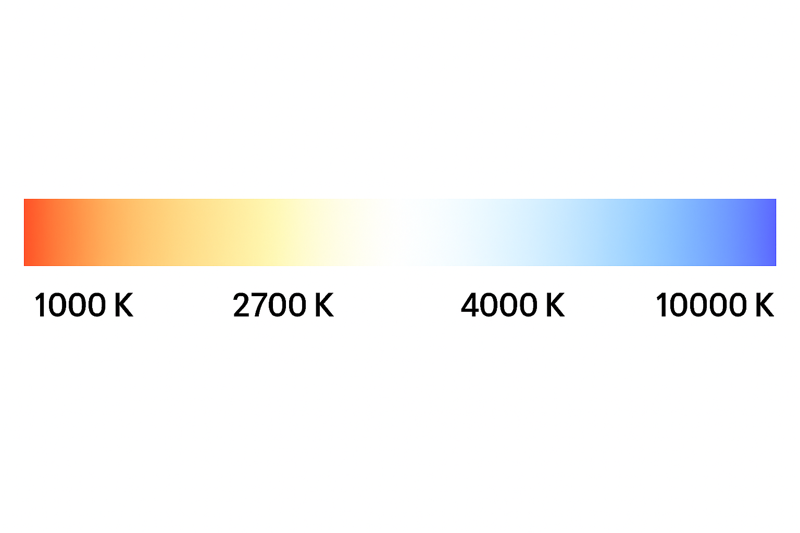
Let's break down this concept because it's the foundation of everything else. It might sound scientific, but the idea is very simple. Think about the sun throughout the day. At sunrise and sunset, the light is very warm, orangey, and red. This would have a very low color temperature. At noon on a clear day, the sunlight is very bright and almost blueish-white. This is a very high color temperature. The Kelvin scale simply puts a number to these colors. It originates from the idea of heating a theoretical black object until it glows. As it gets hotter, it first glows red, then yellow, then white, and finally blue. The temperature of the object at each color point gives us the Kelvin number. For LED bulbs, we use this scale to tell you exactly what shade of white the light will be. At Hongyu Bulb, our manufacturing process includes precise calibration of our LED chips to ensure that a bulb labeled 2700K produces a consistent, beautiful warm light, batch after batch. This consistency is a key mark of a high-quality supplier.
Understanding the Kelvin Scale
This is the language of light color.
- Below 3000K (Warm White1): This range produces a calm, inviting, and intimate glow. It's the yellowish-white light we associate with traditional incandescent bulbs and candlelight. Our most popular candelabra bulbs for residential and hospitality clients fall in the 2700K range.
- 3100K to 4500K (Neutral or Cool White): This range provides a balance between warm and cool. 4000K is a common choice for this range, offering a clean, crisp, and vibrant white light without being too blue or too yellow. It feels modern and efficient.
- Above 4500K (Daylight2): This light is very bright and has a distinctly bluish tint. It's excellent for situations that require high alertness and color accuracy, like a workshop, a jewelry display, or a security area, but it can feel harsh and clinical in a home setting.
Here’s a simple guide to the scale:
| Kelvin Range | Name | Perceived Feeling | Common Analogy |
|---|---|---|---|
| 2000K - 3000K | Warm White | Cozy, Relaxing, Intimate | Candlelight, Sunset |
| 3100K - 4500K | Cool White / Neutral | Clean, Efficient, Modern | Morning Sunlight |
| 4600K - 6500K | Daylight | Alert, Intense, Crisp | High Noon Sun |
Understanding this scale allows you to move from simply selling a "light bulb" to providing a specific "mood" or "feeling," which is a much more powerful way to meet your customers' needs.
When should you choose Warm White (2700K - 3000K)?
Do you know which applications absolutely require warm white light? Placing the wrong color bulb in a space designed for comfort can make it feel sterile and uninviting, hurting sales and satisfaction.
Choose Warm White for any area where relaxation, comfort, and intimacy are the primary goals. It is the standard for living rooms, bedrooms, dining rooms, and most hospitality settings like restaurants and hotel lobbies.
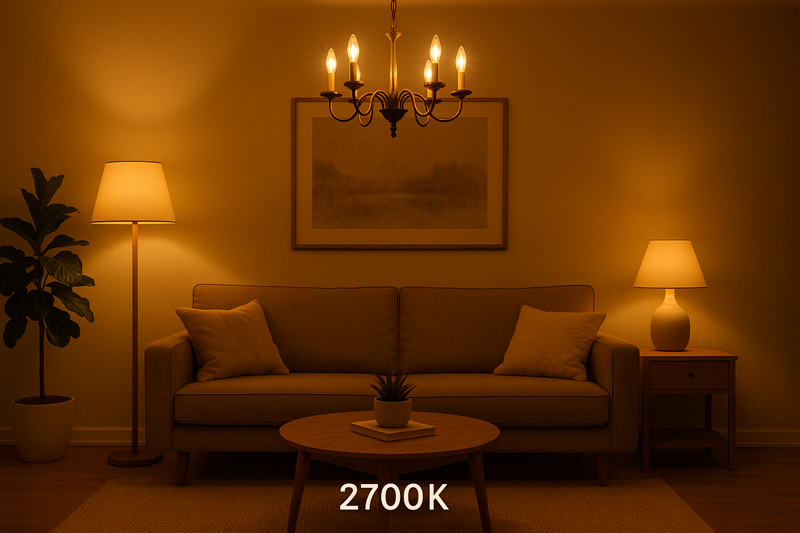
Warm white light does more than just illuminate a room; it sets a mood. From a biological perspective, the human brain associates the yellowish, warm light of a fire or sunset with the end of the day, a time for rest and relaxation. The reduced amount of blue light in its spectrum is less likely to interfere with the body's production of melatonin, the sleep hormone. This is a key reason why it feels so natural and comfortable in our homes, especially in the evening. As a manufacturer for clients across the globe, I can tell you that for decorative E12 and E14 candelabra bulbs, warm white—specifically 2700K—accounts for the vast majority of our orders. It's the safe, classic, and almost universally preferred choice for the fixtures these bulbs are designed for. Buyers like Jacky in the U.S. almost exclusively order 2700K for their residential customers because they know it matches the warmth of the incandescent bulbs people are replacing.
Ideal Applications for Warm White Light3
Let's look at where this color temperature truly shines.
- Residential Spaces:
- Living Rooms: Warm white fosters a comfortable environment for family gatherings, watching movies, and relaxing.
- Bedrooms: It creates a serene and peaceful atmosphere conducive to sleep. Using cool white in a bedroom can feel jarring and disruptive.
- Dining Rooms: It casts a flattering light on people and makes food look more appetizing. The rich, warm tones enhance the dining experience.
- Commercial and Hospitality Spaces:
- Restaurants & Bars: A warm, dimmable light is essential for creating an intimate and upscale ambiance that encourages patrons to stay longer.
- Hotel Lobbies & Lounges: It makes the space feel welcoming and luxurious, providing a comfortable "home away from home" feeling for guests.
- Boutique Retail: Shops selling high-end goods like leather, wood furniture, or fine wines can use warm light to enrich the appearance of their products.
Pairing with Interior Design
Warm white light complements certain design styles perfectly. It is the ideal choice for interiors that feature:
- Natural Materials4: It enhances the rich tones of wood floors, furniture, and cabinetry.
- Warm Color Palettes: It brings out the depth of reds, oranges, yellows, and earthy tones in paint and fabrics.
- Traditional & Rustic Styles: It is essential for achieving an authentic look in farmhouse, traditional, bohemian, or rustic decor.
Choosing warm white isn't just a technical decision; it's a design choice that profoundly impacts how a space is perceived and enjoyed.
When is Cool White (4000K+) the better option?
Are you thinking warm white is always the answer for decorative bulbs? Using it in a modern, functional space can make the area look dated and dim, failing to provide the clarity your customers need.
Choose Cool White for areas that demand energy, focus, and clarity. It is best for modern kitchens, bathrooms, home offices, and commercial retail spaces where accurate color representation and a feeling of cleanliness are important.
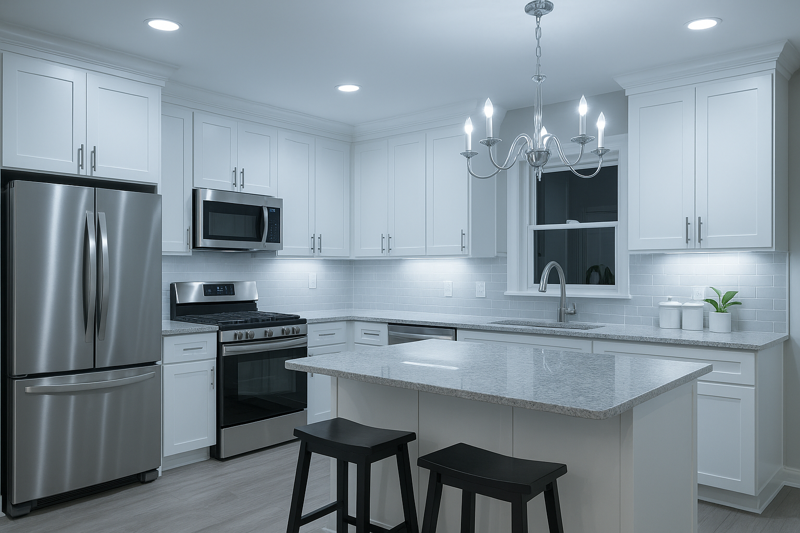
While warm white creates comfort, cool white creates energy. The crisp, white light of a 4000K bulb mimics morning sunlight, which our brains associate with the start of the day and a time for activity and alertness. The higher concentration of blue light in its spectrum can increase focus and productivity. This is why it's so effective in work and task-oriented environments. While less common for a traditional chandelier in a living room, cool white has a definitive and growing place in modern design. For clients in the Netherlands and parts of the UK with a preference for minimalist and contemporary aesthetics, we see a steady demand for 4000K candelabra bulbs. They use them in modern fixtures where the goal isn't to be cozy, but to be clean, sharp, and stylish. It's about providing a functional brightness that also serves a specific design vision.
Ideal Applications for Cool White Light
Here are the environments where cool white excels.
- Task-Oriented Home Areas:
- Kitchens: Cool white light is excellent for food preparation. It helps you clearly see the true colors of ingredients, making tasks like chopping vegetables safer and easier. It also creates a sense of cleanliness.
- Bathrooms: It provides a clean, clear light for grooming tasks like applying makeup or shaving. It makes a white and chrome bathroom look exceptionally bright and sterile.
- Home Offices & Garages: In any space where you are working on projects, reading, or need to stay focused, cool white light is superior.
- Commercial and Retail Spaces:
- Modern Retail: Stores that want to project a sleek, modern, high-tech image, like an electronics store or a contemporary art gallery, benefit from cool white light.
- Jewelry Stores: The crispness of cool white light5, especially in higher Kelvin ranges like 5000K, maximizes the sparkle and brilliance of diamonds and gemstones.
- Commercial Kitchens & Work Areas: For safety and cleanliness, these back-of-house areas require bright, clear illumination.
Pairing with Interior Design
Cool white light is the perfect partner for certain aesthetics. It works best with:
- Cool Color Palettes: It complements blues, greens, grays, and crisp whites, making them appear sharp and true.
- Modern & Minimalist Styles: It enhances the clean lines and simple forms found in contemporary, minimalist, and industrial design.
- Sleek Materials: It reflects beautifully off of materials like chrome, stainless steel, glass, and high-gloss surfaces, amplifying a sense of modern efficiency.
By offering both warm and cool white options, you empower your customers to make the right choice for their specific style and functional needs.
How can you help your customers make the right choice?
Are you worried that your customers will be confused by these options? Simply listing the specs isn't enough; if they choose incorrectly, they may blame your product, leading to returns and poor reviews.
Educate your customers by using descriptive language and visuals. Replace "2700K" with "Cozy & Inviting" and "4000K" with "Clean & Modern." Use side-by-side comparison images and application photos to show the difference in real-world settings.
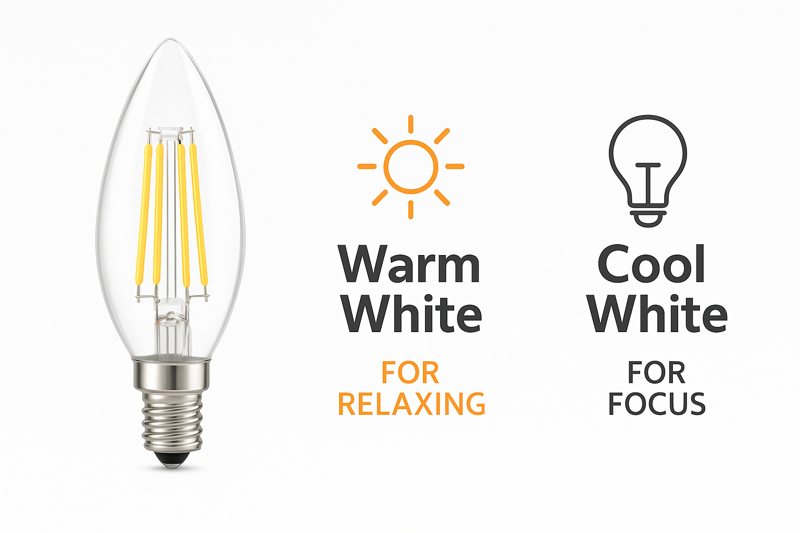
As a B2B manufacturer, my job isn't just to make bulbs; it's to provide my clients—the distributors, importers, and brand owners—with the tools they need to succeed. The end consumer doesn't want to study the Kelvin scale. They just want to buy a bulb that makes their room look good. The responsibility falls on us, the people in the industry, to bridge that knowledge gap. When we develop packaging and marketing materials for our clients, we always push for clarity over technical jargon. A successful product isn't just one that is well-made; it's one that is well-explained. If you make it easy for your customers to choose correctly, your return rates will drop, and your customer satisfaction will soar.
Simplify the Language
Translate technical specifications into emotional benefits.
- For Warm White: Use words like Cozy, Relaxing, Inviting, Traditional, Sunset Glow, Intimate, Candlelight. Frame it as the perfect choice for creating a comfortable home atmosphere.
- For Cool White: Use words like Clean, Crisp, Modern, Focused, Energetic, Daylight-Like, Vibrant. Position it as the ideal choice for work areas and contemporary design.
Use Powerful Visuals
A picture is worth a thousand words, and in lighting, it's worth even more.
- Comparison Photos: Show the exact same room setting lit with a 2700K bulb and a 4000K bulb side-by-side. This is the most effective tool for instantly communicating the difference in mood and feel.
- Application Showcase: Create lifestyle images or a gallery showing warm white bulbs in a cozy living room, a romantic restaurant, and a classic bedroom. Then show cool white bulbs in a sleek kitchen, a bright home office, and a modern bathroom. This helps customers self-select based on where they plan to use the bulbs.
Here’s a quick guide to translating tech specs into customer benefits:
| Technical Spec | Warm White6 (2700K) | Cool White (4000K) |
|---|---|---|
| Product Name | Classic Warm White Candelabra Bulb | Modern Cool White7 Candelabra Bulb |
| Key Adjectives | Cozy, Relaxing, Traditional | Bright, Clean, Focused |
| Best For | Living Rooms, Bedrooms, Dining | Kitchens, Bathrooms, Offices |
| Visual Cue | Image of a comfortable, traditional room | Image of a sleek, contemporary room |
By adopting this educational approach, you transition from being a simple seller of light bulbs to a trusted advisor on lighting design. This builds brand loyalty and gives you a significant competitive advantage.
Conclusion
The difference between warm and cool white is simple yet profound. Warm white creates comfort, while cool white provides clarity. Guiding your customers to the right choice elevates their experience and builds your brand's reputation.
Explore this link to understand how Warm White light can enhance ambiance and comfort in various settings. ↩
Discover the advantages of Daylight lighting for productivity and alertness in workspaces and homes. ↩
Explore how Warm White Light enhances ambiance and comfort in various spaces, making it a popular choice for design. ↩
Discover the relationship between Natural Materials and lighting, and how they can elevate your interior design. ↩
Discover how cool white light enhances visibility and aesthetics in various environments, making it a top choice for both homes and businesses. ↩
Explore how Warm White lighting creates a cozy and inviting atmosphere, perfect for enhancing your home. ↩
Discover how Cool White lighting can energize and modernize your work areas, making them more vibrant and focused. ↩





